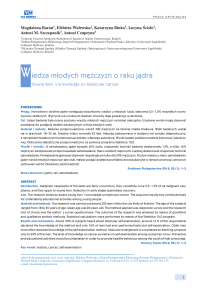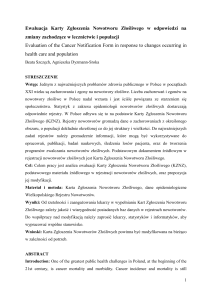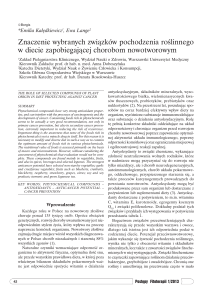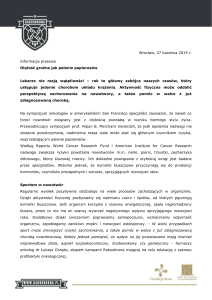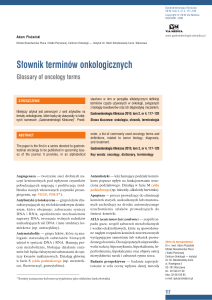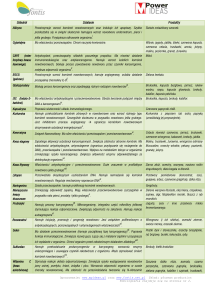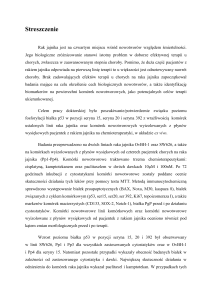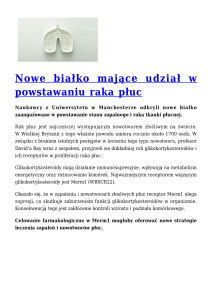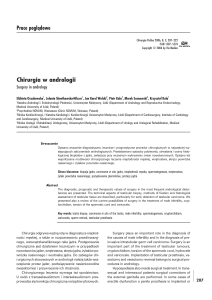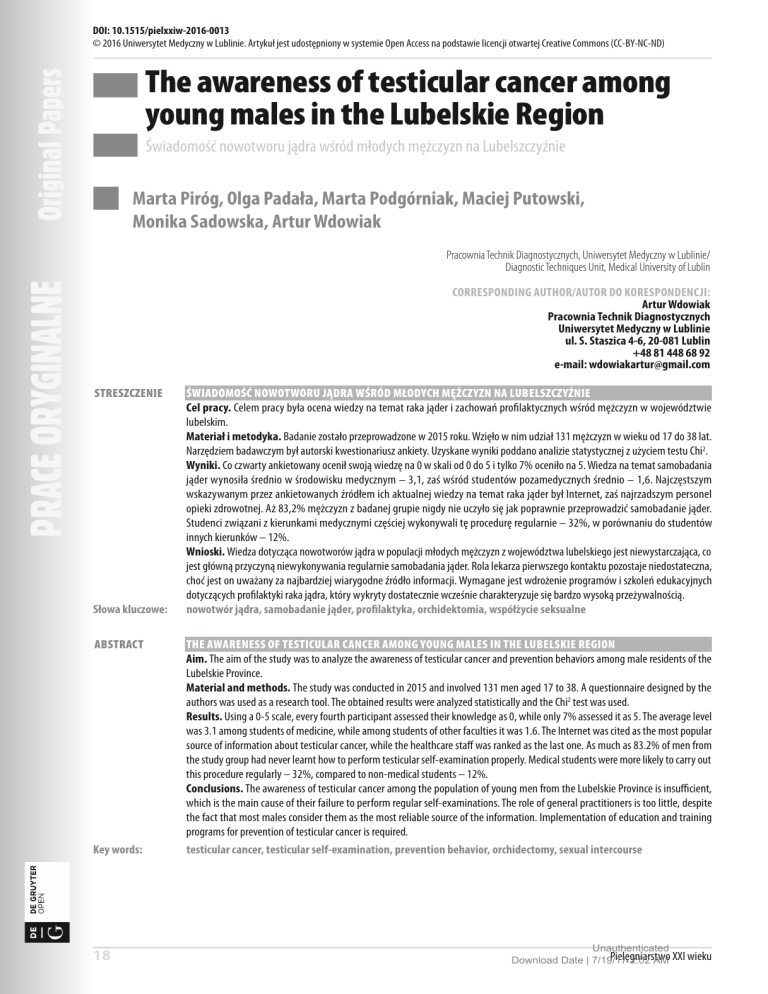
DOI: 10.1515/pielxxiw-2016-0013
© 2016 Uniwersytet Medyczny w Lublinie. Artykuł jest udostępniony w systemie Open Access na podstawie licencji otwartej Creative Commons (CC-BY-NC-ND)
The awareness of testicular cancer among
young males in the Lubelskie Region
Świadomość nowotworu jądra wśród młodych mężczyzn na Lubelszczyźnie
Marta Piróg, Olga Padała, Marta Podgórniak, Maciej Putowski,
Monika Sadowska, Artur Wdowiak
Pracownia Technik Diagnostycznych, Uniwersytet Medyczny w Lublinie/
Diagnostic Techniques Unit, Medical University of Lublin
CORRESPONDING AUTHOR/AUTOR DO KORESPONDENCJI:
Artur Wdowiak
Pracownia Technik Diagnostycznych
Uniwersytet Medyczny w Lublinie
ul. S. Staszica 4-6, 20-081 Lublin
+48 81 448 68 92
e-mail: [email protected]
STRESZCZENIE
Słowa kluczowe:
ABSTRACT
Key words:
18
ŚWIADOMOŚĆ NOWOTWORU JĄDRA WŚRÓD MŁODYCH MĘŻCZYZN NA LUBELSZCZYŹNIE
Cel pracy. Celem pracy była ocena wiedzy na temat raka jąder i zachowań profilaktycznych wśród mężczyzn w województwie
lubelskim.
Materiał i metodyka. Badanie zostało przeprowadzone w 2015 roku. Wzięło w nim udział 131 mężczyzn w wieku od 17 do 38 lat.
Narzędziem badawczym był autorski kwestionariusz ankiety. Uzyskane wyniki poddano analizie statystycznej z użyciem testu Chi2.
Wyniki. Co czwarty ankietowany ocenił swoją wiedzę na 0 w skali od 0 do 5 i tylko 7% oceniło na 5. Wiedza na temat samobadania
jąder wynosiła średnio w środowisku medycznym – 3,1, zaś wśród studentów pozamedycznych średnio – 1,6. Najczęstszym
wskazywanym przez ankietowanych źródłem ich aktualnej wiedzy na temat raka jąder był Internet, zaś najrzadszym personel
opieki zdrowotnej. Aż 83,2% mężczyzn z badanej grupie nigdy nie uczyło się jak poprawnie przeprowadzić samobadanie jąder.
Studenci związani z kierunkami medycznymi częściej wykonywali tę procedurę regularnie – 32%, w porównaniu do studentów
innych kierunków – 12%.
Wnioski. Wiedza dotycząca nowotworów jądra w populacji młodych mężczyzn z województwa lubelskiego jest niewystarczająca, co
jest główną przyczyną niewykonywania regularnie samobadania jąder. Rola lekarza pierwszego kontaktu pozostaje niedostateczna,
choć jest on uważany za najbardziej wiarygodne źródło informacji. Wymagane jest wdrożenie programów i szkoleń edukacyjnych
dotyczących profilaktyki raka jądra, który wykryty dostatecznie wcześnie charakteryzuje się bardzo wysoką przeżywalnością.
nowotwór jądra, samobadanie jąder, profilaktyka, orchidektomia, współżycie seksualne
THE AWARENESS OF TESTICULAR CANCER AMONG YOUNG MALES IN THE LUBELSKIE REGION
Aim. The aim of the study was to analyze the awareness of testicular cancer and prevention behaviors among male residents of the
Lubelskie Province.
Material and methods. The study was conducted in 2015 and involved 131 men aged 17 to 38. A questionnaire designed by the
authors was used as a research tool. The obtained results were analyzed statistically and the Chi2 test was used.
Results. Using a 0-5 scale, every fourth participant assessed their knowledge as 0, while only 7% assessed it as 5. The average level
was 3.1 among students of medicine, while among students of other faculties it was 1.6. The Internet was cited as the most popular
source of information about testicular cancer, while the healthcare staff was ranked as the last one. As much as 83.2% of men from
the study group had never learnt how to perform testicular self-examination properly. Medical students were more likely to carry out
this procedure regularly – 32%, compared to non-medical students – 12%.
Conclusions. The awareness of testicular cancer among the population of young men from the Lubelskie Province is insufficient,
which is the main cause of their failure to perform regular self-examinations. The role of general practitioners is too little, despite
the fact that most males consider them as the most reliable source of the information. Implementation of education and training
programs for prevention of testicular cancer is required.
testicular cancer, testicular self-examination, prevention behavior, orchidectomy, sexual intercourse
Unauthenticated
Pielęgniarstwo
Download Date | 7/19/17
2:02 AM XXI wieku
Marta Piróg, Olga Padała, Marta Podgórniak, Maciej Putowski, Monika Sadowska, Artur Wdowiak
INTRODUCTION
Testicular cancer is a relatively rare tumor type
accounting for 1% of malignancies in men, nevertheless,
it is the most common cancer among young men aged 15
to 35 [1]. Epidemiology studies indicate that in Western
societies, 3-10 new cases occur (out of 100.000 men) [2]
and the incidence rate has been increasing during the last
decades, especially in the industrialized countries [3,4].
In the global perspective, the incidence rate of testicular
cancer has more than doubled during the last 40 years
[5]. Epidemiological risk factors for the development
of testicular tumors include congenital malformations,
like cryptorchidism or hypospadias, familiar history of
testicular tumors among first-grade relatives and the
presence of a contralateral tumor [6,7]. Although neither
one’s lifestyle nor socioeconomic factors have been proven
to cause testicular cancer, they may definitely affect the
hormone levels at various ages, which translates into
promoting the disease. [8]. Detecting types of testicular
cancer is relatively easy, provided that one performs a
testicular self-examination regularly. At the early stages of
development, testicular cancer has one of the highest cure
rates among all cancers. Its average five-year survival rate
reaches 95% [9].
AIM
all. Figure 1 presents the structure of respondents’ education.
Fig. 1. The structure of the education among respondents
The self-assessment of knowledge concerning
the prevention of testicular cancer
Using a 0-5 scale, every fourth participant assessed
their knowledge as 0, while only 7% assessed it as 5.
The average level of knowledge about testicular selfexamination in a 5-point scale was 3.1 in the medical community, while among non-medical students it was 1.6 with
this difference being statistically significant (p < 0.001).
Figure 2 shows the breakdown of students’ knowledge, further divided into their faculties (medical and non-medical).
The aim of the study was to analyze the awareness of
testicular cancer and preventive behaviors among male
residents of the Lubelskie Province.
MATERIAL AND METHODS
The study was conducted in January and February 2015
using a standardized interview. It involved 131 men aged
17 to 38. A questionnaire designed by the authors was
used as a research tool. It included 19 questions, both of
the single and multiple choice type. The obtained results
were analyzed statistically. In order to improve quality, the
Chi2 test was performed to show differences between the
examined groups. The significance level was set at p<0.05,
which indicates the existence of statistically significant
differences or correlations. The database and statistical
analysis was performed using the Statistica 9.1 software
(StatSoft Poland).
RESULTS
The structure of age, education and place
of residence
There were analyzed 131 men, aged 17 to 38 years, with
an average age of 23.4 and median age of 22 years. Most
participants were urban residents (83.2%), while another
16.2% were rural area residents. Most of them were engineering students (29%) and medical students (28.2%). The
students of humanities constituted 15.3% of the respondents, the students of mathematics and science – 13% and
14.5% of the participants had no university education at
Fig. 2. The self-esteem of knowledge about testicular cancer in 5-point
scale
Most students (58%) pointed to the Internet as their
chief source of knowledge about testicular cancer. Other
than that, students pointed to magazines (19.8%) or the
TV (19.8%). The participants were least likely to refer to
healthcare staff, like primary care doctor (2.3%) or nurses
(1.5%) in case they needed any advice. On the other hand,
the participants mentioned primary care physicians as
the most desirable source of information about testicular cancer (59.5%). Also, the respondents mentioned the
Internet (57.3%), specialists (39.6%) and the TV (43.5%).
More detailed information is presented in Figure 3.
At the end of the questionnaire there was a question
Are you going to broaden your knowledge about testicular
cancer prophylaxis? About 20.6% of respondents answered
definitely yes and 56.6% of them rather yes. The answer
rather not was given by 9.9% of the study group members,
while 2.3% answered definitely not and 10.7% of respondents chose the option hard to say.
Unauthenticated
Vol.15, Nr 2(55)/2016
19
Download Date | 7/19/17 2:02 AM
The awareness of testicular cancer among young males in the Lubelskie Region
(p < 0.001). The structure of frequency of self-examination
is presented in Figure 4.
Fig. 3. The current and the most desirable sources of knowledge about
testicular cancer in the opinion of respondents
The knowledge about the cancer
When inquired about the age group most at risk of
developing cancers, some 47.3% of the respondents
answered men between 40 and 65 years of age. The correct
answer young men before 40 years of age was chosen by
35.9% of respondents, while 6.1% chose the answer elderly
men after 60 years of age and 10.7% had no opinion.
Among medical students, 75.5% of the participants were
aware that the cancer affects young men as well, while in
case of the non-medical group, only 20.2% knew that.
Approximately 83.2% of respondents were aware that
cancer detected at an early stage was completely treatable.
Only 2.3% believed that the testicular cancer was never
treatable, 0.8% claimed that it could be cured in every
stage and 13.7% had no opinion.
Most of respondents claimed that removal of a single
testicle would not affect fertility and 38.2% of the respondents believed that unilateral orchidectomy does not
affect the ability to have children, while 38.9% claimed
that having children by such men was likely but rare.
A completely different view was expressed by 11.5% of
the respondents, and the same percentage of them had no
opinion.
Over a half (54.2%) of the respondents believed there
was no relationship between the occurrence of testicular
cancer and the number of sexual partners. About 14.5%
believed it could have some effect and 9.9% believed it was
of great importance. Also, 21.4% had no opinion at all.
Fig. 4. The frequency of testicular self-examination among respondents
of medical and non-medical faculties
The potential source of the support
The study participants had to answer a multiple choice
question: where would you go for help if you had detected
some alarming changes on your testicle? Most respondents
mentioned the physician – 60.3% chose the urologist,
58.8% chose the general practitioner and 3.8% – the physician working for an accident and emergency department. On the other hand, every third respondent regarded
the Internet as the potential source of helpful information. Family and friends accounted for 9.9% of answers
(in which 6.1% for the parents and 3.8% for friends and
brother or sister). Three of the respondents (2.3%) would
have waited until the change disappeared while 4.6% of
participants of the study answered hard to say.
The approach to the subject of testicular cancer
The answers to the question whether the subject of
testicular cancer and its prevention is embarrassing were
rather diverse. About 46.5% of the respondents found the
topic inconvenient. Among them 9.9% chose the answer
definitely inconvenient and 36.6% rather inconvenient. The
opposite view was expressed by 48.9% of the respondents
of whom 17.6% indicated the answer definitely not and
31.3% rather not. As much as 4.6% of the participants of
the study had no opinion.
There is no statistically significant difference between
the medical and non-medical students on the perception
of testicular cancer as an embarrassing subject (p = 0.53).
Self-examination – ability and practice
About 96.9% of respondents had never taken part in
any lectures about testicular cancer prophylaxis while
only 3.1% of them attended some kind of workshops. As
much as 83.2% of men from the study group had never
learned how to perform testicular self-examination properly. Others (16.8%) admitted that they had an opportunity to learn testicular self-examination, out of whom
some 7.6% took part in workshops at school or university,
1.5% – attended workshops conducted by medical organizations and 4.6% were taught by physician during the visit.
As much as 75% of respondents of non-medical faculties had never carried out self-examination of their testicles, while only every fourth medical student provided
a similar answer. Moreover, students associated with the
medical degree course more often carried out this procedure regularly (32%), compared to non-medical students
(12%), with this difference being statistically significant
20
The influence of the potential orchidectomy
on sexual intercourse
The respondents were asked how in their opinion the
orchidectomy would have affected their sexual intercourse. Slightly more than a half of them (50.4%) found
such a situation as a discomfort, which, however, would
not lead to restriction in sexual intercourse. As much
as 17.6% of the respondents claimed that orchidectomy
would have probably restricted their sexual activity. Only
7.6% of them answered that the orchidectomy would not
have influenced their sexual contacts while 5.3% admitted
that it would have led to the resignation of sexual intercourse. Almost every fifth (19.1%) respondent chose the
answer hard to say.
Unauthenticated
Pielęgniarstwo
Download Date | 7/19/17
2:02 AM XXI wieku
Marta Piróg, Olga Padała, Marta Podgórniak, Maciej Putowski, Monika Sadowska, Artur Wdowiak
The spread of the problem of testicular cancer
About 74% of respondents had not known anyone suffering from testicular cancer. The answer I heard about
men suffering from testicular cancer was chosen by 17.6%
of the study group members. About 7.6% of men taking
part in the study admitted that they had known someone suffering from testicular cancer. One person (0.8%)
claimed that in his family there had been a case of the
mentioned disease.
DISCUSSION
According to a number of literature sources on testicular cancer awareness, the level of knowledge among the
young men is relatively low [10,11]. The study conducted
among men in Lubelskie Province leads to a similar conclusion. The knowledge seems to be insufficient, either
in the self-assessment of the respondents or the evaluation based on the questionnaire. However, a significant
difference between medical and non-medical students
was noticed. The higher level of education in the subject
among future healthcare providers appears natural but
in fact it is still unsatisfactory. Furthermore, the health
service does not contribute sufficiently to improve the
awareness of the population. Actually, most men look
for the necessary information about testicular cancer on
the Internet, since this is a widely available and mostly
anonymous source of information. This calls for creating
online resources, providing standardized and authorized
information about the topic. The possibility to gain the
information from the general practitioner should be also
emphasized. Fortunately, there is a widespread need to
extend awareness in this issue.
Testicle self-examination is a readily available, inexpensive and effective method that boosts the chances of
early tumor detection [12]. Unfortunately, a vast majority of young men, residents of the Lubelskie Province had
never had an opportunity to participate in lectures about
the prophylaxis. General practitioners play too little role,
despite the fact that most males consider them as the most
reliable source of the information. During regular checkups, patients in Poland, like in other countries, should
be taught about the ways of preventing testicular cancer.
A study conducted by Handy and Snakar in the United
Kingdom revealed that 40% of the participants pointed
to doctors as their source of knowledge, 30% mentioned
school and 4% mentioned the Internet [13]. British men,
along with their peers from Ireland and Hungary, take the
lead when it comes to testicular cancer prevention.
Notwithstanding that, the percentage of men performing the testicular self-examination in other European
countries is inappropriately low with the numbers as follows: 6.5% in Iceland, 9.6% in the Netherlands and 12.3%
in France [14]. Men have little awareness of testicular
cancer preventions methods, which translates into lack of
self-examination. The consequence of knowledge deficits
might be undue delay in diagnosis of the disease [15]. The
study by Öztürk confirmed that the relationship between
one’s education and tumor detection is more significant
than in case of age or financial status. The second impor-
tant reason is the embarrassment which restrains patients
from consulting the doctor [16]. In the current study the
ambivalent approach of the respondents was revealed.
Almost half of them felt inconvenient about the subject,
while the other half did not feel confused. Worryingly,
in the group of respondents there were three men who
would have decided not to consult the specialist after
detecting the lesion and wait for its spontaneous disappearing.
In fact, there are some opinions which impair the
validity of testicular self-examination due to causing
false-positive results increasing unnecessary anxiety.
[17] Contrary to them Rovito states that these arguments
are illogical because there is existing evidence that late
stage of testicular cancer is associated with deep depression. Moreover, there are many benefits of testicular selfexamination including improving health outcomes and
self-awareness of the body [17]. Certainly, the advantages
of testicular self-examination are more evident than its
drawbacks, which is why it should be carried out regularly.
Both American Cancer Society and American Urological
Association have recommended testicular examinations as
parts of routine check-ups. Additionally, the whole of the
healthcare staff should be obliged to teach testicular selfexamination and encourage all male patients aged 15 to 35
to engage in that kind of activity [18].
Although, the subject of testicular cancer is generally
regarded embarrassing, more than a half of the respondents claimed that it would have not lead to restriction
in sexual intercourse. The study by Wortel showed that
treatment of testicular cancer could influence negatively
the sexual activity of the patients, however, the number of
sexually active patients after orchidectomy remained on a
stable level [19].
The authors of the present study hope that their findings will contribute to greater interest in the issues of
young men testicular self-examination and indicate new
directions in health promotion.
CONCLUSIONS
The knowledge about the testicular cancer among
young men is insufficient, resulting in lack of preventive
measures. General practitioners play too little role, despite
the fact that most males consider them as the most reliable source of the information. Men have little awareness
of this problem which is why they fail to conduct a testicular self-examination regularly. Taking into consideration
that there are respondents who have never heard about
a possibility of examining themselves and the frequency
of testicular cancer is increasing, the education of young
people is necessary.
Unauthenticated
Vol.15, Nr 2(55)/2016
21
Download Date | 7/19/17 2:02 AM
Świadomość nowotworu jądra wśród młodych mężczyzn na Lubelszczyźnie
Świadomość nowotworu jądra wśród młodych mężczyzn
na Lubelszczyźnie
WPROWADZENIE
nowili jedynie 16,2%. Wśród kierunków studiów dominowały kierunki techniczne (29,0%) oraz medyczne (28,2%).
Studenci kierunków humanistycznych stanowili 15,3%
ankietowanych, studenci kierunków ścisłych – 13,0%,
a 14,5% ankietowanych nie miało statusu studenta uczelni
wyższej. Struktura wykształcenia ankietowanych została
przedstawiona na rycinie 1.
Rak jądra jest stosunkowo rzadkim typem nowotworu
stanowiącym 1% wszystkich nowotworów złośliwych
u mężczyzn, jednakże jest to najczęstszy nowotwór złośliwy wśród młodych mężczyzn od 15 do 35 roku życia
[1]. Badania epidemiologiczne prowadzone na Zachodzie wykazują, że każdego roku pojawia się 3-10 nowych
przypadków nowotworu jąder na 100 000 mężczyzn [2],
a częstość występowania w ciągu ostatnich dziesięcioleci
wzrasta, szczególnie w krajach uprzemysłowionych [3,4].
W ciągu ostatnich 40 lat zapadalność na nowotwór jądra
na świecie wzrosła ponad dwukrotnie [5]. Do epidemiologicznych czynników ryzyka należą wady wrodzone, takie
jak wnętrostwo i spodziectwo, rodzinna historia występowania nowotworów jąder wśród krewnych pierwszego
stopnia oraz guz strony przeciwnej [6,7]. Dotychczas nie
udowodniono wpływu stylu życia i czynników społecznoekonomicznych na rozwój raka jąder, ale niektóre z nich
wydają się odgrywać rolę w promowaniu choroby poprzez
wpływ na równowagę hormonalną na różnych etapach
życia [8]. Systematyczne samobadanie jąder jest stosunkowo prostą metodą pozwalającą wykryć zdecydowaną
większość typów raka jądra, które we wczesnym stadium
mają jeden z najwyższych wskaźników pięcioletniej przeżywalności o wartości 95% [9].
Ryc. 1. Struktura wykształcenia wśród ankietowanych
Samoocena wiedzy na temat profilaktyki raka
jądra
Co czwarty ankietowany ocenił swoją wiedzę jako 0
w skali od 0 do 5, natomiast zaledwie 7% przyznało sobie
ocenę 5. Średni poziom wiedzy na temat samobadania
jąder w 5-punktowej skali wynosił 3,1 wśród studentów
kierunków medycznych, podczas gdy w grupie pozostałych ankietowanych było to zaledwie 1,6. Różnica ta była
istotna statystycznie (p<0,001). Samoocena wiedzy na
temat profilaktyki raka jądra w 5-punktowej skali wśród
studentów uczelni medycznych i niemedycznych zaprezentowana jest na rycinie 2.
CEL PRACY
Celem pracy była ocena wiedzy na temat raka jąder
i zachowań profilaktycznych wśród mężczyzn w województwie lubelskim.
MATERIAŁ I METODY
Badanie zostało przeprowadzone w styczniu i lutym
2015. Wzięło w nim udział 131 mężczyzn w wieku od 17
do 38 lat. Narzędziem badawczym był autorski kwestionariusz ankiety, który zawierał 19 pytań, zarówno pojedynczego jak i wielokrotnego wyboru. Uzyskane wyniki
badań poddano analizie statystycznej. Dla cech jakościowych do wykrycia istnienia zależności pomiędzy analizowanymi zmiennymi użyto testu Chi2. Przyjęto poziom
istotności p<0,05. Bazę danych i badania statystyczne
wykonano w oparciu o oprogramowanie komputerowe
Statistica 9.1 (StatSoft Poland).
Ryc. 2. Samoocena wiedzy w 5-punktowej skali na temat profilaktyki
raka jądra
WYNIKI BADAŃ
Najbardziej powszechnym źródłem wiedzy na temat
nowotworu jądra w badanej grupie był Internet (58,0%).
Oprócz tego badani wymieniali również prasę (19,8%)
oraz telewizję (19,8%). Najrzadziej wymienianym źródłem
informacji był personel medyczny, taki jak pielęgniarka
(1,5%) oraz lekarz pierwszego kontaktu (2,3%). Z drugiej
strony, lekarz pierwszego kontaktu był wskazywany jako
najbardziej pożądane źródło wiedzy na temat nowotworu
Struktura wieku, wykształcenia i miejsca
zamieszkania ankietowanych
Badanie obejmowało 131 mężczyzn w wieku od 17 do
38 roku życia. Średni wiek wynosił 23,4, a mediana – 22
lata. Zdecydowana większość ankietowanych (83,2%)
zamieszkiwała miasta, podczas gdy mieszkańcy wsi sta-
22
Unauthenticated
Pielęgniarstwo
Download Date | 7/19/17
2:02 AM XXI wieku
Marta Piróg, Olga Padała, Marta Podgórniak, Maciej Putowski, Monika Sadowska, Artur Wdowiak
jądra (59,5%). Respondenci wskazywali również Internet
(57,3%), lekarza specjalistę (49,6%) oraz telewizję (43,5%).
Obecne oraz najbardziej pożądane źródła wiedzy na temat
nowotworu jąder przedstawiono na rycinie 3.
Ryc. 3. Źródła aktualnej i pożądanej wiedzy nt. nowotworu jądra wśród
ankietowanych
Na końcu kwestionariusza zadano pytanie Czy planujesz poszerzać swoją wiedzę na temat profilaktyki raka
jądra? Około 20,6% ankietowanych udzieliło odpowiedzi
zdecydowanie tak, a 56,6% z nich – raczej tak. Odpowiedź
raczej nie została wybrana przez 9,9% respondentów,
a zdecydowanie nie przez 2,3% z nich. 10,7% ankietowanych wybrała opcję trudno powiedzieć.
tylko 3,1% uczestniczyło szkoleniu w tego typu. Około
83,2% mężczyzn z grupy badanej nigdy nie uczyło się
wykonywać prawidłowo samobadania jąder. Pozostali
(16,8%) przyznali, ze mieli okazję nauczyć się wykonywania samobadania, z czego 7,6% brała udział w warsztatach
w szkole lub na uniwersytecie, 1,5% – w warsztatach prowadzonych przez organizacje medyczne, a 4,6% uzyskało
te wiedzę od lekarza podczas wizyty.
Aż 75% ankietowanych studentów uczelni niemedycznych nigdy nie przeprowadziło samobadania jąder, podczas gdy tylko jedna czwarta spośród studentów uczelni
medycznych odpowiedziała podobnie. Co więcej, mężczyźni związani z kierunkami medycznymi częściej przeprowadzali tę procedurę regularnie (32%), w porównaniu
do kierunków niemedycznych (12%). Różnica ta była
istotna statystycznie (p<0,001). Częstość przeprowadzania
samobadania jąder w grupie ankietowanych jest przedstawiona na rycinie 4.
Wiedza na temat nowotworu
Zapytani o grupę wiekową o najwyższym ryzyku
wystąpienia nowotworu, większość ankietowanych
(47,3%) wybrała odpowiedź mężczyźni pomiędzy 40 a 65
rokiem życia. Właściwa odpowiedź, młodzi mężczyźni
przed 40 rokiem życia, została wskazana przez 35,9%
respondentów, 6,1% wybrała odpowiedź starsi mężczyźni
po 60 roku życia, a 10,7% nie miała zdania na ten temat.
W grupie studentów uczelni medycznych 75,5% ankietowanych było świadomych wysokiej zapadalności na
nowotwór wśród młodych mężczyzn, podczas gdy wśród
studentów niemedycznych było to tylko 20,2%.
W przybliżeniu 83,2% respondentów była świadoma
faktu, iż nowotwór wykryty we wczesnych stadium jest
całkowicie wyleczalny. Tylko 2,3% uznało, że nowotwór jądra nigdy nie jest wyleczalny, 0,8% stwierdziło, że
może być wyleczony w każdym stadium zaawansowania,
a 13,7% nie miało zdania.
Większość ankietowanych była zadania, że usuniecie
jednego jądra może pozostać bez wpływu na płodność
w późniejszym życiu. Około 38,2% z nich uważa, że spłodzenie dziecka po jednostronnej orchidektomi jest możliwe zawsze, podczas gdy 38,9% twierdzi, że jest to możliwe, ale rzadkie. Dokładnie 11,5% ankietowanych była
przeciwnego zdania, a taki sam procent nie miał opinii na
ten temat.
Ponad połowa (54,2%) ankietowanych uznała, że
duża liczba partnerek seksualnych nie wpływa na ryzyko
występowania raka jądra. Około 14,5% stwierdziło, iż
może mieć to niewielki wpływ, natomiast 9,9% – że ma to
znaczne znaczenie. Aż 21,4% nie ma zdania na ten temat.
Samobadanie – umiejętności i praktyka
Aż 96,9% respondentów nigdy nie brała udziału w zajęciach poświęconych profilaktyce raka jądra, podczas gdy
Ryc. 4. Częstość wykonywania samobadania jąder wśród studentów
medycznych i pozamedycznych
Miejsce zgłaszania się po pomoc
Uczestnikom badania zadano pytanie wielokrotnego
wyboru: Gdzie szukałbyś pomocy w przypadku wykrycia niepokojących zmian w obrębie jądra? Zdecydowana
większość respondentów wskazała na lekarza: 60,3%
wybrało urologa, 58,8% lekarza rodzinnego a 3,8% ankietowanych zgłosiłoby się na szpitalny oddział ratunkowy.
Co trzeci respondent wskazał Internet jako potencjalne
źródło przydatnych informacji. Odpowiedź rodzina
i przyjaciele wybrało 9,9% badanych (w tym 6,1% rodzice
i 3,8% przyjaciele/rodzeństwo). Trzech mężczyzn (2,3%)
czekałoby, aż zmiana zniknie. 4,6% respondentów udzieliło odpowiedzi trudno powiedzieć.
Personalny stosunek do tematu raka jąder
Odpowiedzi na pytanie, czy temat raka jądra i jego
profilaktyki jest wstydliwy, były rozbieżne. Prawie połowa
(46,5%) respondentów odpowiedziała twierdząco. Wśród
nich 9,9% wybrało odpowiedź zdecydowanie tak, a 36,6%
raczej tak. Przeciwny pogląd miało 48,9% ankietowanych,
z których 17,6% wskazało odpowiedź zdecydowanie nie,
a 31,3% raczej nie. Tylko 4,6% uczestników badania nie
miało zdania. Nie stwierdzono statystycznie istotnej różnicy pomiędzy studentami uczelni medycznych i niemedycznych w kwestii postrzegania tematu raka jądra jako
tematu wstydliwego (p = 0,53).
Unauthenticated
Vol.15, Nr 2(55)/2016
23
Download Date | 7/19/17 2:02 AM
Świadomość nowotworu jądra wśród młodych mężczyzn na Lubelszczyźnie
Wpływ potencjalnej orchidektomii
na współżycie seksualne
w tej dziedzinie jest również niedostateczna, zwłaszcza
zważywszy na fakt, że większość mężczyzn uważa, że
lekarz pierwszego kontaktu byłby najbardziej wiarygodnym źródłem informacji. Pacjenci powinni mieć zatem
możliwość zapoznania się z techniką samobadania jąder
jako prostej metody profilaktyki w trakcie wizyty w gabinecie lekarskim. Takie działania stanowią normę postępowania w innych krajach: w badaniach Handy’ego przeprowadzonych w Wielkiej Brytanii 40% uczestników potwierdziła znajomość techniki samobadania jąder nabytej od
lekarza pierwszego kontaktu. Drugim wskazanym źródłem wiedzy okazała się szkoła (30%), podczas gdy Internet stanowił jedynie 4% odpowiedzi ankietowanych [13].
Wielka Brytania, Węgry oraz Irlandia to kraje, w których
kładzie się największy nacisk na profilaktykę nowotworu
jądra, jednak nie jest to zjawisko powszechne. Wśród
mieszkańców innych państw europejskich stwierdza się
niski odsetek mężczyzn podejmujących działania mające
na celu prewencję nowotworów jądra – wśród Islandczyków jest to 6,5% mężczyzn, natomiast wśród Holendrów
i Francuzów odpowiednio 9,6% i 12,3% [14]. Przyczyną
takiego stanu rzeczy jest przede wszystkim niska świadomość w tej tematyce.
Konsekwencją niedostatecznej wiedzy w zakresie nowotworów jądra może być niepożądania zwłoka
w postawieniu odpowiedniej diagnozy [15]. Potwierdza to
analiza Öztürka, która wykazała, że niski poziom edukacji
ma większy wpływ na opóźnienie diagnozy w porównaniu
z czynnikami takimi jak wiek czy status materialny. Drugi
istotny powód wskazany przez Öztürka to onieśmielenie
przyczyniające się do odwlekania konsultacji potencjalnych zmian chorobowych z lekarzem [16]. W badaniu
na grupie populacji lubelskiej wykazano mieszany stosunek respondentów do tej tematyki. Niemal połowa z nich
określiła temat nowotworu jądra jako niekomfortowy,
podczas gdy druga połowa wskazała, że nie powoduje on
dyskomfortu. Co niepokojące, troje uczestników badania
nie zdecydowałoby się na wizytę u specjalisty w przypadku wykrycia niepokojących zmian, oczekując ich
samoistnego zaniku.
Niektóre opinie negują znaczenie samobadania jąder
i wskazują ich potencjalną rolę w stwarzaniu niepotrzebnego niepokoju związanego z fałszywie pozytywnymi
wynikami tej procedury [17]. W opozycji do nich, Rovito
ocenia ten argument jako nielogiczny. Istnieją bowiem
dowody, że obecność zmian nowotworowych wykrytych w późnym stadium rodzi znacznie większy niepokój, a nawet głęboką depresję. Dodatkowo, podkreśla on
inne korzyści płynące z regularnego samobadania takie
jak zwiększenie świadomości własnego ciała oraz odpowiedzialności za swoje zdrowie [17]. Bez wątpienia, zalety
płynące z podejmowania tej metody profilaktyki przeważają nad wadami, co potwierdza konieczność przeprowadzania samobadania systematycznie. Amerykańskie Towarzystwo Onkologiczne oraz Amerykańskie Stowarzyszenie
Urologiczne zalecają wprowadzenie badania jąder jako
elementu rutynowego badania fizykalnego. Rekomendują
także zobligowanie personelu pielęgniarskiego do zachęcania i zaznajamiania z tą procedurą wszystkich pacjentów
płci męskiej pomiędzy 15 a 35 rokiem życia [18].
Respondentów zapytano, jaki ich zdaniem byłby wpływ
braku jądra na ich życie seksualne. Nieco ponad połowa
z nich (50,4%) stwierdziła, że byłby to dyskomfort, który
jednak nie doprowadziłby do ograniczenia współżycia
płciowego. Aż 17,6% respondentów twierdziło, że orchidektomia prawdopodobnie ograniczyłaby ich aktywność
seksualną. Tylko 7,6% ankietowanych odpowiedziało, że
orchidektomia zupełnie nie wpłynęłaby na ich kontakty
seksualne, podczas gdy 5,3% przyznało, że brak jądra
doprowadziłby do rezygnacji ze stosunków płciowych.
Prawie co piąty (19,1%) respondent wybrał odpowiedź
trudno powiedzieć.
Rozpowszechnienie tematu raka jądra
Około 74% respondentów przyznało, że nie zna nikogo
ze zdiagnozowanym nowotworem jądra. Odpowiedź Słyszałem o przypadku raka jądra, ale nie znam osobiście
chorego została wybrana przez 17,6% członków grupy
badanej, a 7,6% ankietowanych przyznało, że zna osobę
chorą na raka jądra osobiście. Jeden mężczyzna (0,8%)
przyznał, że w jego bliskiej rodzinie wystąpił przypadek
tego nowotworu.
DYSKUSJA
W nawiązaniu do licznych źródeł literatury, wiedza na
temat nowotworu jądra w populacji młodych mężczyzn
jest stosunkowo niska [10,11], co potwierdziło badanie
przeprowadzone wśród młodych mężczyzn w województwie lubelskim. Świadomość tej tematyki wydaje się być
niewystarczająca, co wnioskować można z samooceny
osób poddanych badaniu, a także ewaluacji opartej na
wynikach kwestionariusza. Co istotne, odnotowano znaczącą różnicę poziomu wiedzy wśród studentów uczelni
medycznych, w porównaniu do osób studiujących na kierunkach pozamedycznych. Wyższy poziom świadomości zauważony w pierwszej grupie badanych wydaje się
być naturalny, jednakże pozostaje on wciąż nie w pełni
satysfakcjonujący. Obecnie, służba zdrowia niewystarczająco przyczynia się do poprawy świadomości zagrożenia
nowotworem jądra. Większość mężczyzn niezbędnych
informacji poszukuje w Internecie, co związane jest z największą dostępnością oraz możliwością pozostania anonimowym. Rodzi to ogromną potrzebę stworzenia źródeł
internetowych, w których zagadnienia dotyczące tej tematyki byłyby wystandaryzowane i zaaprobowane przez środowiska medyczne. Należy także podkreślać możliwość
pozyskiwania odpowiedzi na wszelkie nurtujące kwestie
u lekarza pierwszego kontaktu. Co pocieszające, wykazano, że wśród osób poddanych badaniu, istnieje wyraźna
potrzeba poszerzania wiedzy o występowaniu i profilaktyce nowotworów jądra.
Samobadanie jąder stanowi dostępną, niedrogą, a jednocześnie efektywną metodę wczesnej detekcji zmian
nowotworowych [12]. Niestety, większość młodych
mężczyzn w województwie lubelskim przyznaje, że nie
doświadczyła okazji wzięcia udziału w warsztatach dotyczących tego typu profilaktyki. Rola lekarza rodzinnego
24
Unauthenticated
Pielęgniarstwo
Download Date | 7/19/17
2:02 AM XXI wieku
Marta Piróg, Olga Padała, Marta Podgórniak, Maciej Putowski, Monika Sadowska, Artur Wdowiak
Pomimo, że wielu respondentów określiło temat nowotworu jądra jako wstydliwy, potencjalnie większość z nich
nie postrzegałaby go jako powodu do ograniczenia kontaktów seksualnych. Badania Wortela pokazały, że terapia
nowotworowa wpływa negatywnie na aktywność seksualną, jednakże liczba pacjentów po orchidektomii zachowujących tę aktywność pozostaje niezmieniona [19].
Mamy nadzieję, że uzyskane przez nas wyniki przyczynią się do większego zainteresowania młodych mężczyzn
problematyką samobadania jąder a także wyznaczą nowe
kierunki w promocji zdrowia.
WNIOSKI
Wiedza młodych mężczyzn na temat raka jądra jest
niewystarczająca, co skutkuje brakiem działań profilaktycznych. Działania lekarzy w zakresie edukacji są zdecydowanie za mało intensywne, pomimo faktu, że większość
mężczyzn uważa lekarzy za najbardziej rzetelne źródło
informacji. Mała świadomość problemu jest głównym
powodem braku regularnej samokontroli. Biorąc pod
uwagę fakt, że są respondenci, którzy nigdy nie słyszeli
o możliwości przeprowadzenia samobadania oraz dane
wskazujące na to, że częstość zachorowań na raka jądra
rośnie, konieczna jest edukacja młodych ludzi.
PIŚMIENNICTWO
1. Curado MP, Edwards B, Shin HR, et al. Cancer incidence in five continents. IX. IARC
Press. France: 2007; 160.
2. Engholm G, Ferlay J, Christensen N, et al. NORDCAN--a Nordic tool for cancer
information, planning, quality control and research. Acta Oncol. 2010;49(5): 725736.
3. Nigam M, Aschebrook-Kilfoy B, Shikanov S, et al. Increasing incidence of testicular
cancer in the United States and Europe between 1992 and 2009. World Journal of
Urology. 2015;33(5): 623-631.
4. Huyghe E, Matsuda T, Thonneau P. Increasing incidence of testicular cancer
worldwide: a review. Journal of Urology. 2003;170(1): 5-11.
5. Bethesda. National Cancer Institute, Testicular Cancer Screening (PDQ®): Health
ProfessionalVersion 2015,http://www.ncbi.nlm.nih.gov/books/NBK65967/ [accesed:
26.02.2016]
6. Lip SZ, Murchison LE, Cullis PS, et al. A meta-analysis of the risk of boys with isolated
cryptorchidism developing testicular cancer in later life. Archives of Diseases in
Childhood. 2013;98(1): 20-26.
7. Forman D, Oliver RT, Brett AR, et al. Familial testicular cancer: a report of the UK
family register, estimation of risk and a HLA class 1 sib-pair analysis. British Journal
of Cancer. 1992;65(2): 255-262.
8. Boyle P, Zaridze DG. Risk factors for prostate and testicular cancer. European Journal
of Cancer. 1993;29A: 1048-1055.
9. Testicular Cancer Overview. American Cancer Society. http://www.cancer.org/acs/
groups/cid/documents/webcontent/003079-pdf.pdf [accesed: 2016-02-07].
10. Braga IC, Cabral J, Louro N, et al. Testicular Cancer Awareness and Knowledge: Is
It the Same? Exploratory Study in a Mixed-Gender Population. Journal of Cancer
Education. 2015:1-7.
11. Wanzer MB1, Foster SC, Servoss T, et al. Educating young men about testicular
cancer: support for a comprehensive testicular cancer campaign. Journal of Health
Communication. 2014;19(3): 303-320.
12. Moore RA, Topping A. Young men’s knowledge of testicular cancer and testicular
self-examination: a lost opportunity? European Journal of Cancer Care. 1999;8(3):
137-142.
13. Handy P, Sankar KN. Testicular self-examination – Knowledge of men attending
a large genito urinary medicine clinic. Health Education Journal. 2008;67: 9-15.
14. Evans EC, Steptoe A, Wardle J. Testicular selfexamination: change in rates of practice
in European university students, from 13 countries, over a 10-year period. The
Journal of Men’s Health & Gender. 2006;3: 368-337.
15. Casey RG, Grainger R, Butler M, et al. Scrotal signs and symptoms in the general
population, the value of testis self-examination and the pitfalls of a scrotal
screening programme: is the two-week rule relevant? World Journal of Urology.
2011;29: 387-391.
16. Öztürk Ç, Fleer J, Hoekstra HJ, et al. Delay in Diagnosis of Testicular Cancer; A Need for
Awareness Programs. PLoS One. 2015;10(11).
17. Rovito MJ. Performing Testicular Self-Examination, Driving Automobiles, and
Anxiety: What Is the Logical Link? American Journal of Men’s Health. 2016. pii:
1557988316635048. [Epub ahead of print].
18. Ward KD, Vander Weg MW, Read MC, et al. Testicular cancer awareness and self
examination among adolescent males in a community - based youth organization.
Preventive Medicine. 2005;41: 386-398.
19. Wortel RC, Ghidey Alemayehu W, et al. Orchiectomy and radiotherapy for stage I-II
testicular seminoma: a prospective evaluation of short-term effects on body image
and sexual function. The Journal of Sexual Medicine. 2015;12(1): 210-218.
Praca przyjęta do druku/Manuscript received:
08.04.2016
Praca zaakceptowana do druku/Manuscript accepted:
20.04.2016
Tłumaczenie/Translation: Marta Piróg
Unauthenticated
Vol.15, Nr 2(55)/2016
25
Download Date | 7/19/17 2:02 AM

